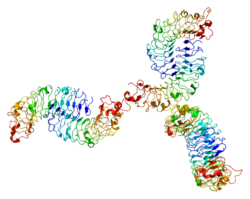Biglycan
Biglycan is a small leucine-rich repeat proteoglycan (SLRP) which is found in a variety of extracellular matrix tissues, including bone, cartilage and tendon. In humans, biglycan is encoded by the BGN gene which is located on the X chromosome.
The name "biglycan" was proposed in an article by Fisher, Termine and Young in an article in the Journal of Biological Chemistry in 1989 because the proteoglycan contained two GAG chains; formerly it was known as proteoglycan-I (PG-I).
Biglycan consists of a protein core containing leucine-rich repeat regions and two glycosaminoglycan (GAG) chains consisting of either chondroitin sulfate (CS) or dermatan sulfate (DS), with DS being more abundant in most connective tissues. The CS/DS chains are attached at amino acids 5 and 10 in human biglycan. The composition of the GAG chains has been reported as varying according to tissue of origin. Non-glycanated forms of biglycan (no GAG chains) increase with age in human articular cartilage.
...
Wikipedia




